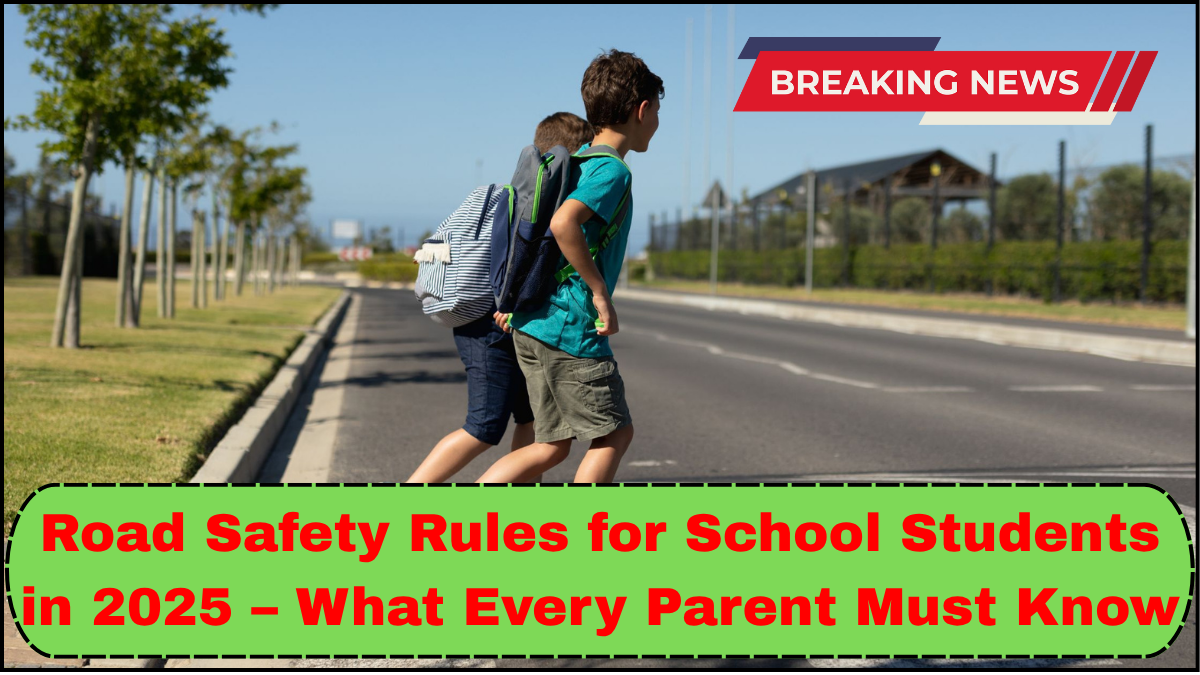As we move further into the digital age, the way children commute to school is rapidly evolving. With the rise in electric vehicles, smart traffic systems, and dense urban traffic, the importance of updated road safety rules for school students in 2025 cannot be overstated. For parents, staying informed isn’t optional—it’s vital. Knowing what has changed and how to guide your child can mean the difference between a safe journey and a serious risk.

Why Road Safety Matters More Than Ever in 2025
Today’s roads are more complex than they were just a few years ago. The surge in two-wheeler deliveries, e-bikes, and autonomous vehicles means students are exposed to new and unpredictable hazards. Parents must understand these shifts to equip their children with the knowledge they need to stay safe.
Updated Road Safety Rules for School Students in 2025
The government and traffic authorities have revised several guidelines to protect school-going children. Here are the most critical updates parents need to be aware of:
1. Mandatory Reflective Gear
In 2025, students commuting on foot or by bicycle are required to wear reflective backpacks or vests, especially during early morning or late evening hours. These high-visibility items help ensure that young pedestrians are seen by motorists in all lighting conditions.
2. Revised Helmet Rules for Students
The helmet rules have been tightened, and rightfully so. Children riding bicycles, scooters, or pillion on two-wheelers must wear certified helmets—no exceptions. Parents should invest in size-appropriate, ISI-marked helmets and teach children how to fasten them correctly every time.
3. Smart School Zones
Many urban areas have implemented smart school zones that use AI-powered cameras to enforce speed limits. These zones also include automated pedestrian alerts and speed bumps. Students should be taught to recognize these areas and stay within the designated paths.
4. Safe Bus Commuting Practices
For students using school buses, authorities now require:
-
Seatbelts on every seat.
-
CCTV surveillance inside the bus.
-
A trained attendant on board.
Parents should routinely ask their child about these conditions and report any deviations to the school administration.
5. Importance of Zebra Crossing Awareness
Zebra crossing awareness is critical. Children should be taught that merely standing at a zebra crossing doesn’t guarantee vehicles will stop. They must:
-
Make eye contact with drivers before stepping onto the crossing.
-
Raise their hand to signal their intent.
-
Wait until the vehicle has come to a complete halt.
How Parents Can Reinforce These Safety Measures
1. Lead by Example
Children mimic adults. If you jaywalk, skip helmets, or ignore traffic lights, they’ll assume it’s acceptable. Follow the rules yourself every time you’re on the road.
2. Conduct Weekly Safety Drills
Practice scenarios at home or in your neighborhood:
-
How to cross roads with no signals.
-
How to identify a distracted driver.
-
How to handle emergencies like losing a bus or getting off at the wrong stop.
3. Use Technology to Educate
Leverage child-friendly apps and animated videos that teach road safety rules for school students in 2025. Interactive content sticks better than verbal instructions alone.
4. Stay Connected With the School
Many schools now hold safety awareness programs in collaboration with traffic authorities. Attend these sessions and encourage your child’s participation.
Key Safety Reminders for Parents in 2025
-
Never allow underage children to ride e-bikes or electric scooters.
-
Ensure your child’s school ID contains emergency contact numbers.
-
Install GPS trackers if your child uses personal transport or carpools.
-
Regularly inspect the condition of helmets and reflective gear.
Frequently Asked Questions (FAQs)
Q1: At what age is it legal for students to ride bicycles on public roads in 2025?
A: Most jurisdictions allow children aged 10 and above to ride bicycles on designated bike lanes. However, they must wear helmets and follow traffic signals strictly.
Q2: Is it mandatory for students to wear helmets on e-scooters?
A: Yes. As per updated helmet rules, all riders, regardless of age, must wear helmets while using electric scooters or bikes.
Q3: What should a parent do if their child’s school bus lacks safety features?
A: Immediately report the issue to the school administration and local transport authorities. In 2025, all school transport must comply with standard safety protocols.
Q4: How can I help my child become more aware of zebra crossings?
A: Practice with them in real scenarios. Teach them to look both ways, raise a hand to signal, and never assume vehicles will stop unless there’s confirmation.
Q5: Are there any penalties for students not following road safety rules?
A: While students may not face legal penalties, schools and parents can implement disciplinary actions. In some cases, local authorities may issue warnings to guardians.
click here to learn more